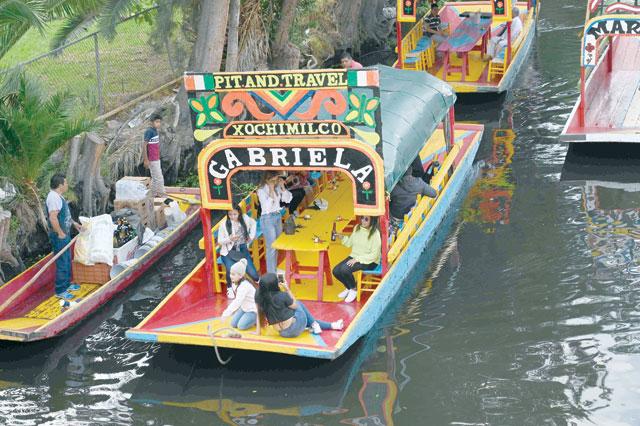You are here
Drowning rocks Mexico's idyllic floating gardens
By AFP - Oct 10,2019 - Last updated at Oct 10,2019

Visitors aboard Trajineras sail in Xochimilco, Mexico City, on Saturday (AFP photo)
MEXICO CITY — Noe Carmona is poling his small boat around Mexico City's floating garden district, Xochimilco, trying to sell roasted corn to tourists in the colorful gondolas that lazily ply the canals
It is after noon, but clients are scarce, and he has yet to make a sale.
Visitor numbers have plunged by 80 per cent since a young man drowned here on September 1, authorities say.
"I'm thinking about looking for another job," says Carmona, a lithe man of 32 who supports his three children doing this — his profession since he was eight years old.
"I used to make about 2,000 pesos [$100] a day. Now I'm making about 200 or 300," he tells AFP.
"Look at this: There's hardly anyone here," says another vendor, 55-year-old Isabel Chavez.
She sells handmade sweets, but has left much of her stock at home, fearing it will go unsold and spoil. Her sales are down by 90 per cent, she estimates.
Xochimilco, a maze of canals and artificial islands created centuries ago by the area's indigenous peoples, is a UNESCO World Heritage Site that draws around one million tourists a year.
An idyllic splash of green improbably tucked into the sprawl of this capital of nine million people, it is a perfect place for a relaxing getaway with family and friends.
Floating mariachi bands serenade visitors, and vendors in small boats drift past selling food, drinks, flowers and handcrafts.
But then, like a large rock thrown into a peaceful pond, "the incident" happened: An intoxicated 20-year-old fell off a gondola and drowned.
Xochimilco is still struggling with the ripple effects.
Fending off safety fears, local authorities sharply restricted alcohol sales this month, began requiring life jackets and banned sound systems from party boats.
But so far, the new rules exist mainly on paper. And locals say the restrictions are not helping bring the tourists back anyway.
Horror, then helplessness
On September 1, a group of young friends from Puebla state, just east of Mexico City, rented several gondolas, or "trajineras", for a birthday party at Xochimilco.
Drinking and dancing, they started climbing from boat to boat, when a 20-year-old identified as Jose Manuel fell in the water.
"No! No!" shouted his friends, as one kept recording video on a cell phone.
After a moment of horrified shock, they tried to help him. But Jose Manuel never resurfaced. His body was found the next day.
It was not the first drowning in Xochimilco.
At least six people have drowned here in the past two years, according to El Heraldo de Mexico newspaper.
But it was the first such incident to be filmed. The clip went viral online and was picked up by Mexican media.
"It was the video and the social networks that did us in," says Jose Zaldivar, director general for tourism in Xochimilco's local government.
Rules and reality
Zaldivar's office presented gondoliers at the Nuevo Nativitas docks with 116 life jackets on Saturday, then pasted the new regulations inside their boats.
In addition to requiring life jackets, the measures limit alcohol consumption to 1 liter of hard liquor per boat or three beers per person. They also forbid climbing from boat to boat.
But rules are one thing. Reality is another.
There are not nearly enough life jackets to go around — just two or three per gondola, even though the boats have a capacity of 18. The release forms passengers are supposed to sign if they do not want to wear life jackets have not yet been printed.
Then there is the question of how to regulate alcohol consumption.
Authorities have increased patrols in Xochimilco since the drowning, but even Zaldivar admits they are largely relying on visitors' goodwill.
"It's impossible to have 1,100 people out here supervising every gondola in Xochimilco," he says.
He acknowledges there is a fragile balance between safety and fun.
For some visitors, life jackets and booze limits undermine the carefree liberty that Xochimilco is all about.
"Kids my age, we want to be happy, we like to drink," says 19-year-old student Tania Silvan on her way to a trajinera.
Locals are split over whether the solution is more regulation or less.
"This is a first step, but they need to do more... like provide first-aid training," says Amaury Iniestra, 23, who sells handcrafts at the docks.
The authorities have proposed such training, but say they still have to work out the details.
Other vendors — especially those who sell alcohol from floating bars or the artificial islands known as "chinampas" — complain the new regulations are hurting their livelihood, and say individuals should take responsibility for their own behaviour.
There is consensus on one thing, though: Tourism has yet to bounce back.
Related Articles
MEXICO CITY — Mexico’s axolotl salamander can almost magically heal itself, holding the power to regrow its heart and brain.
ROME — More than 40 migrants are feared dead off Italy's Lampedusa after a lone 11-year-old survivor said the boat she was on capsized, a re
It has been a year since the ship went down, and still the memories torment the Syrian refugee












